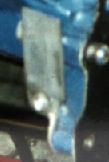 [ ARCHIVES ][ TECHNICAL ][ ARTICLES ][ MY GRABBER ][ PARTS ][ LINKS ][ SITE INDEX ]
[ ARCHIVES ][ TECHNICAL ][ ARTICLES ][ MY GRABBER ][ PARTS ][ LINKS ][ SITE INDEX ]
Late Model 302 into a Maverick or Comet
TECHNICAL ARTICLE

[ Why a late-model 5.0? | Balancing Differences | Using a stickshift | Cam & Firing Order | Misc. ]
Why a Late Model 5.0L?
|
Over the years, Ford improved the 302 to meet the ever-increasing demands of emission and performance standards. The 302 made 225 horsepower in 1987, its highest rating ever. Fuel injection was not the only reason for the increased performance. In 1982, the Mustang GT was revived along with the 302 2V. "The Boss is Back" ads proclaimed. The new 1982 302 was improved in every way. A new 50 oz balance, new, lighter block casting and a new alumimum intake were the major differences. In 1983, the 302 became the 5.0 HO with a 4V, and a legend was born. The 1985-1995 HO engines boasted a roller cam, 2-pc fuel pump eccentric, roller timing chain, thinner rings, and much more power. All of these parts make the engine more efficient and allow it to make more power while still getting good fuel mileage. Granted, an older 302 can be made to be just as efficient as a later model engine, but if you are looking for a powerplant, why not start more towards the end of the 302's evolution? This article will explain how to get a later 302 into your Maverick or Comet. NOTE: All 351W engines have the 28 oz imbalance, so keep in mind that these guidelines do not apply to them. |
Balancing Differences
|
The 1968-1979 302s (and all 289s/351Ws) used a 28 oz imbalance. The 1982-up 302s use a 50 oz imbalance. What this means is you cannot use a flywheel, flexplate, or harmonic balancer from an old 302/289. Swapping the balancer and flexplate/flywheel WILL NOT WORK because the crankshaft is a different balance. This is generally not a problem when using an automatic transmission, just be sure that your flexplate will fit in the bellhousing of your transmission. If it does not, you'll have to do some searching. This swap has become more and more popular, and aftermarket swap flexplates are available. Most machine shops can also balance your older flexplate/flywheel to the 50 oz imbalance. |
Using a Stickshift
|
Beginning with the Mustang II, Ford started using a cable clutch instead of a mechanical linkage. So when they redesigned the 302 block in 1981 they left off the pivot point for the older mechanical linkage. This is a problem if you are using the factory mechanical linkage. Total Performance sells a bracket for this purpose, but they are not difficult to fabricate. Here is a close up of mine (viewable in the top picture as well).  If you are swapping from an automatic to a manual, check out my Stickshift swap article |
Camshaft and Firing Order
|
The firing order is determined by the camshaft in your engine. If you change the camshaft, then this information may not be valid. There are three kinds of 302s made from 1982-2001.
ALL 302 5.0L engines from 1982-up have the 50 oz imbalance. You can retrofit a roller cam in any of these blocks if they are cast with the roller lifter holddown bosses. These are two threaded bosses in the lifter valley. Most blocks after 1987 have these bosses, and 351W engines after 1995 have them. |
Misc. Items
|
| I swapped a 1987 Mustang 5.0L HO into my 1970 Maverick originally equipped with a 250 I6. I am running a Ford Duraspark distributor triggering a Holley ignition, and a Weiand Stealth manifold with a Holley 750. Behind the engine is a T5 which replaced my toploader. If you have any questions about this swap, feel free to contact me on the Maverick Message Board. |